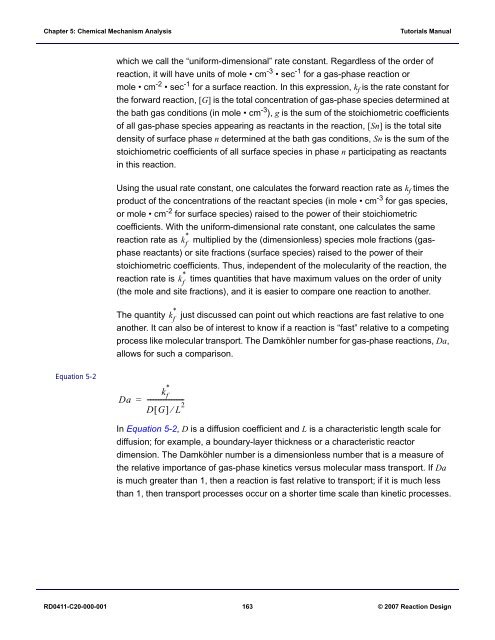Tutorials Manual
Tutorials Manual
Tutorials Manual
You also want an ePaper? Increase the reach of your titles
YUMPU automatically turns print PDFs into web optimized ePapers that Google loves.
Chapter 5: Chemical Mechanism Analysis<br />
<strong>Tutorials</strong> <strong>Manual</strong><br />
which we call the “uniform-dimensional” rate constant. Regardless of the order of<br />
reaction, it will have units of mole • cm -3 •sec -1 for a gas-phase reaction or<br />
mole • cm -2 •sec -1 for a surface reaction. In this expression, k f is the rate constant for<br />
the forward reaction, [G] is the total concentration of gas-phase species determined at<br />
the bath gas conditions (in mole • cm -3 ), g is the sum of the stoichiometric coefficients<br />
of all gas-phase species appearing as reactants in the reaction, [Sn] is the total site<br />
density of surface phase n determined at the bath gas conditions, Sn is the sum of the<br />
stoichiometric coefficients of all surface species in phase n participating as reactants<br />
in this reaction.<br />
Using the usual rate constant, one calculates the forward reaction rate as k f times the<br />
product of the concentrations of the reactant species (in mole • cm -3 for gas species,<br />
or mole • cm -2 for surface species) raised to the power of their stoichiometric<br />
coefficients. With the uniform-dimensional rate constant, one calculates the same<br />
*<br />
reaction rate as k f multiplied by the (dimensionless) species mole fractions (gasphase<br />
reactants) or site fractions (surface species) raised to the power of their<br />
stoichiometric coefficients. Thus, independent of the molecularity of the reaction, the<br />
*<br />
reaction rate is k f times quantities that have maximum values on the order of unity<br />
(the mole and site fractions), and it is easier to compare one reaction to another.<br />
*<br />
The quantity k f just discussed can point out which reactions are fast relative to one<br />
another. It can also be of interest to know if a reaction is “fast” relative to a competing<br />
process like molecular transport. The Damköhler number for gas-phase reactions, Da,<br />
allows for such a comparison.<br />
Equation 5-2<br />
Da =<br />
k f<br />
*<br />
----------------------<br />
DG [ ] ⁄ L 2<br />
In Equation 5-2, D is a diffusion coefficient and L is a characteristic length scale for<br />
diffusion; for example, a boundary-layer thickness or a characteristic reactor<br />
dimension. The Damköhler number is a dimensionless number that is a measure of<br />
the relative importance of gas-phase kinetics versus molecular mass transport. If Da<br />
is much greater than 1, then a reaction is fast relative to transport; if it is much less<br />
than 1, then transport processes occur on a shorter time scale than kinetic processes.<br />
RD0411-C20-000-001 163 © 2007 Reaction Design
















